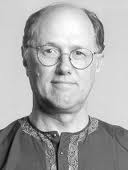by
George Wolfe
(Christmas, 2013)
There are many science-minded people who scoff at the word “spirit.” In our age when the human genome has been mapped, and genes can be spliced and altered, there is a tendency to look at humans as complex, genetically programmed organisms having little influence on individual motivation and destiny. A skeptical friend of mine even refers to words like “spirit” as mumbo jumbo. Well then, what about the “Spirit of Christmas?” Is that also mumbo jumbo?
While the concept of spirit may seem vague, indefinable and problematic to a scientist, to the artist it is a very tangible, experiential phenomenon. The Italian expression con spirito, (which means, with spirit), is a common marking in musical scores.
Spirit is the energy that animates and brings an artwork to life. It is what inspires, generates passion and makes possible an intense mental focus. Spirit also gives us clarity of mind and a determined will.
To my students at Ball State, I explain spirit as being comparable to the concept of “chi” in Chinese Taoist philosophy. While our outer physical strength fades as we grow old, chi is the inner strength that can actually grow stronger as one ages. It is chi that enables a person to see their way through the trials of life and acquire great social influence that can endure well beyond death.
An awakened spiritual energy instills within us a sense of wholeness and a higher, more inclusive awareness whereby we experience the ineffable and recognize the whole as greater than the sum of its parts. One becomes a visionary with a positive sense of purpose and the power to manifest one’s vision. The spirit is that force which enables us to exceed our expectations; to experience what psychologist Abraham Maslow called the “peak experience.” It is the spirit that distinguishes the creative self-modifying intelligence in humans from the programmed artificial intelligence of machines.
Some people say that inspired states of mind and peak experiences can be explained by random chance and biochemical changes in the body, but the fact is, they can’t entirely.
Anyone who has been deeply in love with someone or something knows that lasting love and commitment is more than hormones. Anyone who has had a peak experience, where they lifted an entire team or audience and performed well beyond expectations, knows that spirit is intimately connected with both individual and collective will power. It is focus and determination, mind over matter so to speak, made possible by a higher spirit within us, that makes these transforming experiences possible.
We see this often in the performing arts and athletics, and in social activists like Cesar Chavez, Martin Luther King Jr. and Lech Wałęsa who mustered up the strength and courage to stand against injustice. And we can experience it this time of year if we let go of commercialism and allow ourselves to be inspired by the true meaning of Christmas.
Live your life with spirit. Let the spirit of Christmas lift you to new heights of forgiveness and generosity. Make room for the Divine Child within. The spirit is what makes life dynamic, meaningful, and inspiring to others. That is what grants us our measure of immortality.
George Wolfe is the Coordinator of Outreach Programs for the Ball State University Center for Peace and Conflict Studies. He also chairs the Muncie Interfaith Fellowship, is a trained mediator, and the author of The Spiritual Power of Nonviolence: Interfaith Understanding for a Future Without War.




